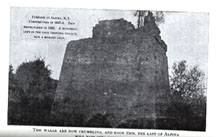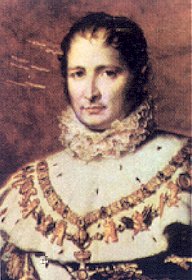
If you tell people you are going to Lake Bonaparte or that you are from around there, you usually have some explaining to do:
The Bonaparte for whom the lake is named was Joseph, the taller, older, more handsome, better humored, and less effectual brother of Napolean, whom Napolean had employed as a diplomat, a soldier, as king of Naples, and, briefly, as king of Spain.
After being overthrown while commanding his troops against the larger force of the British led by the Duke of Wellington, Joseph fled to France, but soon after that, Napolean was sent into island exile and the whole Bonaparte family was outlawed in France.
Joseph left France, and went to Switzerland, leaving his wife, but bringing along his personal secretary Louis Maillard, his valet, and a trove of jewels. He stayed in Switzerland long enough to establish a hideaway where he burried part of the jewel trove. Then, leaving the valet at the hideaway, sailed for America with his secretary Maillard, who looked after one suitcase of jewels amounting to six million dollars, which at the time was enough to start a small country in the New World. Joseph would give that a try.
Though Joseph was not a gifted administrator, he was a good humored diplomat who had in 1800 negotiated some French and American differences, and had since maintained contact with Henry Clay in Philadelphia, and with Bonapartists in the Delaware valley.
With part of his loot, Joseph purchased a thousand acres along the Deleware and there he developed an estate including a half mile long aritificial lake with landscaped islands at its center and a house connected by a tunnel to a landing at the river.
The Delaware river property was a fine showplace for Joseph to establish his credibility, but it was an estate without an income and he was still a man without a country. Joseph sent his secretery back to Switzerland to dig up and return with the burried jewels.
A group of French expatriots had already purchased large tracts in unsettled Northern New York, so for another fistfull of jewels, Joseph bought a chunk of territory a little further up into the wilderness.
At the center of the map was the lake shaped something like the Mediteranian Sea, or maybe a Fler di Louis, or, to be more accurate, like a liver, but which he named "Diana" after the goddess of the hunt.
Of course it was fated from then and forever to be called "Lake Bonaparte".
From his base at the lake his men would eventually scout the surrounding hills for a fertile table land to be cleared and planted, but his first residence and staging place in the North Country was a half day's ride down off the granite in the Village of Natural Bridge just a few yards from where (and sixty years before) my family home was built.
At Natural Bridge, the Indian river, acid tan from steeping in cedar bogs, flows off the granite and dissolves its way right under a limestone ledge.... emerging again a hundred yards away .
It might be more accurate to call the effective result a culvert than a bridge, but either way, it was natural that traffic would cross here, and that people would gather around and try to make something more of it.
Although mostly unaware of Joseph's penchant for tunnelling, Bonaparte folk like to repeat the story that Joseph, fearing assasination, constructed his Natural Bridge house with an escape tunnel leading from his basement to the caverns, but we don't usually believe it ourselves. He did lay out the streets for Natural Bridge, and the plan was not violated until The nineteen fifties when main street got straightend out thanks to an artifical bridge over the Indian River. The tiny cavern tour business was never the same afterwards.
Besides brochure type stories of secret tunnels and burried jewels, it is written with more credibility that Joseph had ordered the Natural Bridge house to be lined with sheet iron to make it bullet proof.
My grandmother Failing took one of the few photos of Bonaparte's Natural Bridge place behind the house where she and my mother were born, and where I lived until I was six years old. The clapboards in the picture seem to be splitting off, but you can't see whether the house had already been stripped of sheet iron.
When I was still living in Natural Bridge, all the siding and framing of the Bonaparte house was gone or rotted, but the empty foundation hole was still there. As I was roaming in the back yards one day shortly before we moved to Ithaca, three older boys, saying that the hole was a Snake Pit, threw me into it. I saw no snakes, no tunnel entrance, and no sheet iron; just a rusty forged nail, bent like a finger, which I did not pick up.
Joseph with his retinue and guests came to his northern kingdom in groups of as many as fourty, traveling mostly by horse and carriage from Philadephia, New York, and New Jersey. About this time, the railroad made its way up here in order to bring iron ore down to the Erie Canal, so Joseph built himself a spur line to his lake, and he was able to bring his guest the rest of the way in the latest style, as well as to transport heavy building materials and bulky items like the six oared gondola he had ordered from Italy.
On the lake shore Joseph built his grand "Hermitage" which would be the scene of hunting parties, gregarious festivities, and amorous affairs, as well as a launching point for those expeditions to scout for a tilable table-land. I think there are no pictures of his "Hermitage", and the name probably doesn't give a good idea of how it appeared. At the outlet of the lake, he directed the clearing of thirty two acres and began construcdtion of an intended summer house and outbuildins, but this would never be occupied by him.
Among the guest hermits in the few seasons of Joseph's presence here, was Joseph's American mistress Annette Savage, who was, as it is generally put "of a good Quaker family" from near Philadelphia
With better luck all around, she might have become queen; She did at least become the mother of Joseph's child Caroline.
But a few of Joseph's expeditions into the beaver flows among bare granite knobs, made it obvious that this land of snow and flies would be a country without a breadbasket. He sold his north country holdings and Joseph retreated to New Jersey, where he had built a house for Annete. Leaving her there, he sailed to Florence Italy where he had been born as "Guisippi Nabolean" and where he would die hoping for a Bonaparte restoration.
When the sometime king Joseph Bonaparte went back to the old World, Lake Diana took on his name along with new and multiple owners. At the outlet of the lake, which had proven a bust as an agricultural site, and an even worese choice as a location for Joseph's summer lodging, a series of local speculators began their attempts to make a mining and smelting center, based on wishful thinking , the presence of a very little, low grade bog ore, and plans for carting in ore from other, richer sites.
On the 32 acre cleared site which Joseph had already cleared, Joseph Phaud and partners built and Christened "Alpina," and which we now usually pronounce "Alpeen", with no conscious reference to mountains, being as there are none in sight.
They brought a road through the knobs and swamps, carted in limestone blocks and laid up the kiln. Benton was a popular and effective enough leader that he could command his men to move mountains, and soWhen the usable loal bog ore was used up in the first firing, they moved a mountian of iron ore from miles across the lowlands and fired again, long enough to exhaust the funds of the original, and then a second set of investors. But there is the convention in this country that it takes three strikes to make an out.
Joseph Bonaparte's sometime and somewhat official American wife, Annette Savage married another man and moved to New York City, but her daughter by Joseph, Caroline Christina Bonaparte, married Zebulon Benton, a Civil war commander and native of Oxbow, New York, who took an interest in the North Country property. Benton, whom many called Zeb, and who would much rather be called Colonel, appeared in Bonaparte country affecting the Napoleanic hat with a ninety degree twist. He enlisted local friends, partners and even a banker investor, and proceeded to refire the kiln, with about the only new aspect of the operation being a paddlewheel boat powered by a team of horses which supplied Alpina with limestone and other supplies for the kiln and village operations, although the ore still came by oxcart over bog and knob. Thus Benton quickly and colorfully exhausted his own and borrowed money. His overinvested Watertown bank took over the business and went broke attempting to keep the doomed town alive. Caroline left Alpina early on, and would live out her days in the North Country teaching French and piano, while Zebulon Benton lingered alone at Alpina long after just about others; and if there was a house still standing he would haunt it.
The village of Alpina lasted long enough for at least one or two children to be born there. I was told by my mother that Ernie Thomas, the Lumberjack, hunter trapper, fisherman who was my Grandrfather's best friend was born there and I read in his niece Elizabeth Vanwyck's accounts that Ernie Thomas's son Harlan who helped build our Loon Island camp, was born there, though I doubt that they both were.
When I was a child there were still remains of a building with a cupola standing in the water at the Alpina dam and a few house foundations still had wood in them.
Only the kiln stands yet, though it is slowly being mounted by trees like a typical Myan ruin. We used to hunt around it and find blue slag, which we collected as Bonaparte turquiois. On the ground right in the mouth of the kiln, I found the passport of a Russian soldier. It was in English, which would be a pretty good indication that it was a fake, no doubt related to Pine Camp military reservation war games.
Although the village is gone now, Zebulon Benton and the enterprise he capped made a permenant impression on the lake landscape. An internet search for Alpina N.Y. will bring it up. The dam fathered several islands, including Loon Island, and there remains the kiln, now slumped into a stable pyramid by which he and the long gone villagers of Alpina will be remembered:
I think of Ernie Thomas, my Grandfather's close friend, who while returning on the ice one Feburary from running his trapline, went through the ice less then a mile from Alpina and whose body was never recovered. Or of that crazy lost Russian soldier who hid with the porcupines and lost his passport there.

Foot Notes:
Irv Priest , whose series of little Bonaparte histories is my source for much of this information, was himself a major and colorful Bonaparte historical figure himself. A store keeper, marina operator, mailman , ice man, land lord, and printer and historian, he omited from his histories an account of the most sucessfull and long lived empire on the lake; his own. He reigned still when I was a kid and identified him with uncle Sam, whom he resembled.
In a contrubution to one of Irv Priest's histories, J. Perine,a long time Bonaparte camper and Utica Saturday globe Editor, wrote that he had been among those who dismantled the Bonapargte house so that something else could be built in its place. Perine claimed to have carried off a single door hinge from the building , and noted that the inovative hammered lead plumbing left behind was gradually used up by boys who played in the abandoned building for years afterwards, and bussied themselves beating the lead into sinkers for their fishing. Those were the good old days, if you didn't bite too much lead.
Just when we were about to move from Natural Bridge, Moe Morgan bought the caverns and the store next to them with the concession to run the cavern tour which takes people a hundred yards or so in a poled boat. You climb out at a sink hole beach on the other side of the road. There is more cavern and an unknown flooded section beyond that to the spring hole where the river emerges again.
There are numerous sink holes all around Natural Bridge, including one behind the school which was a trash dump up into the nineteen fifties, and which in the two thousand fifties, will be an archeological dig.
Ten or fifteen years ago - thirty or so years after we had moved to Ithaca, returning to Bonaparte evcery summer - I stopped by Morgan's store , especially because Moe had told my family hw wanted to ask me a question.
He said that my father had once told him that us boys had once found another entrance to the caverns out back somewhere. He asked me, "Do you remember saying that? Do you remember where?
I don't know and I won't tell."
Moe died a few years, and his son David, who had taken over the caverns and store, died last year. I don't know if Moe ever found the secret entrance.


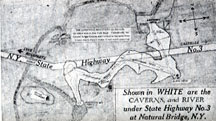
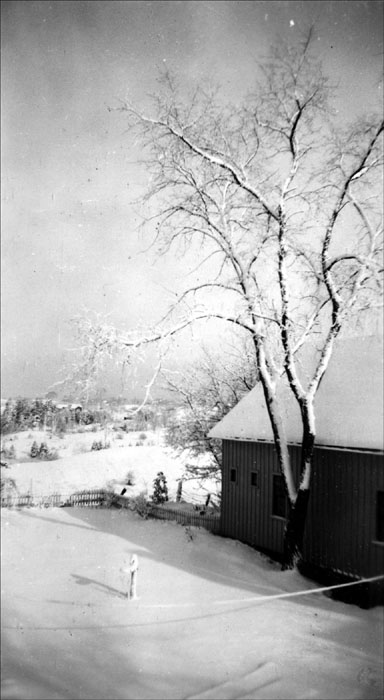
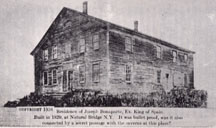
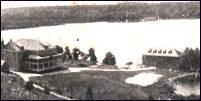
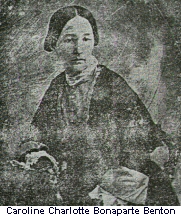
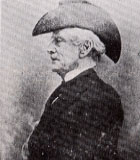
If you should (ill advisedly set off to visit the forbidden ghost town of Alpina) beware of the Military security patrols, the God awful bugs, and lingering spirit of this broken man.
